
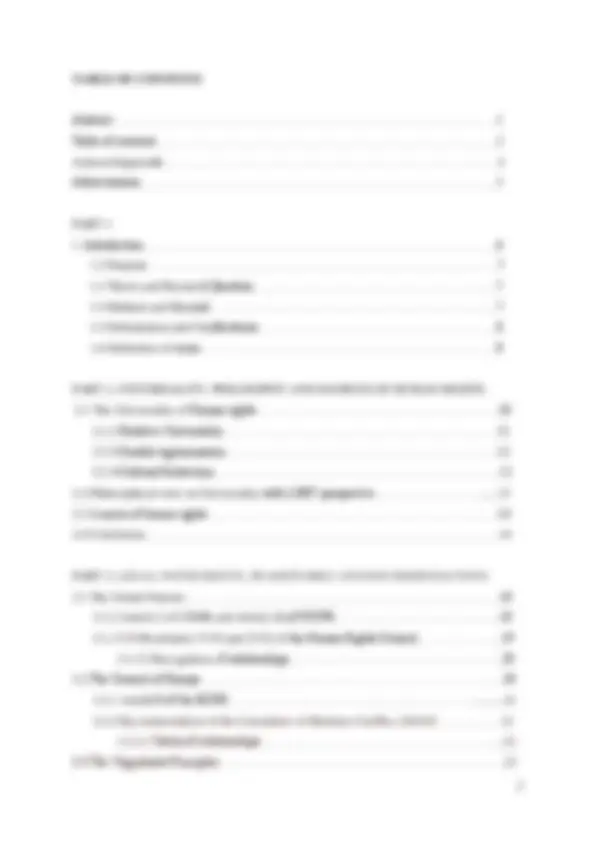
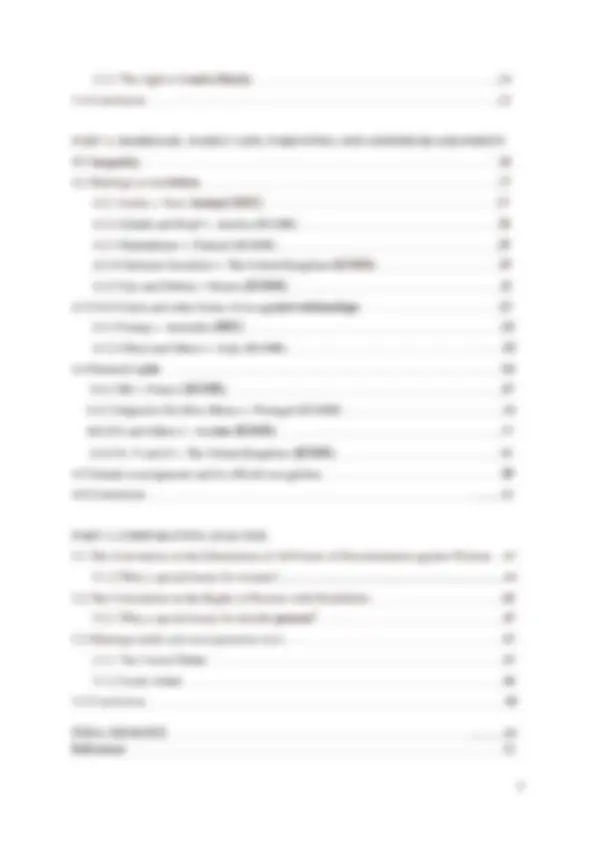

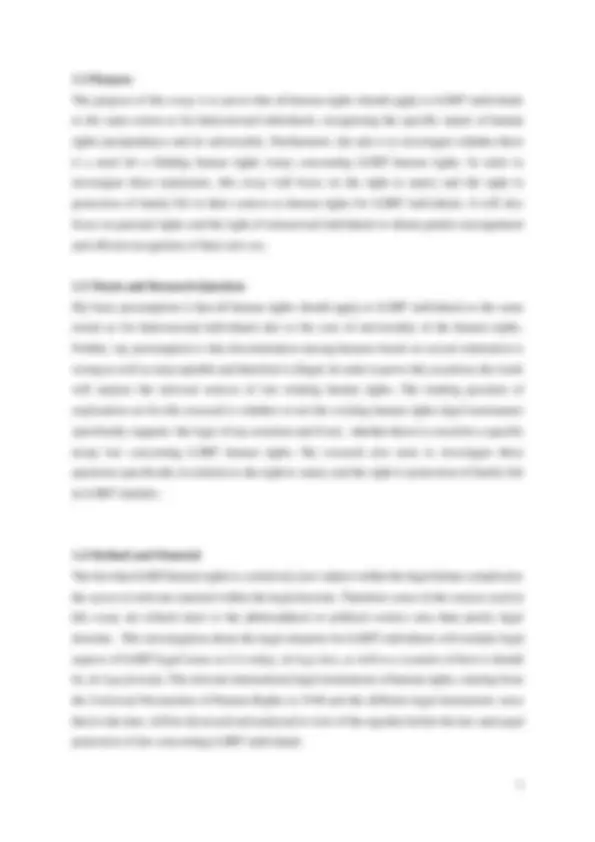
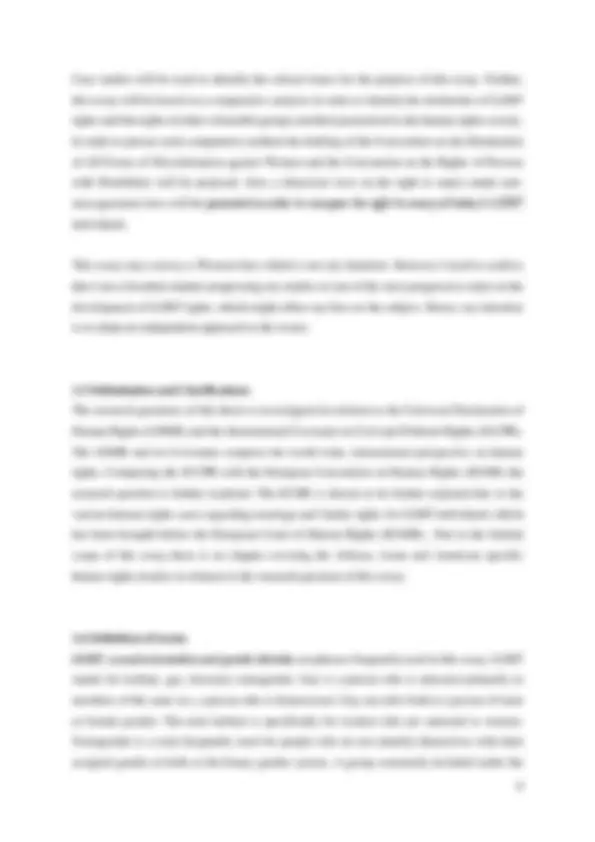
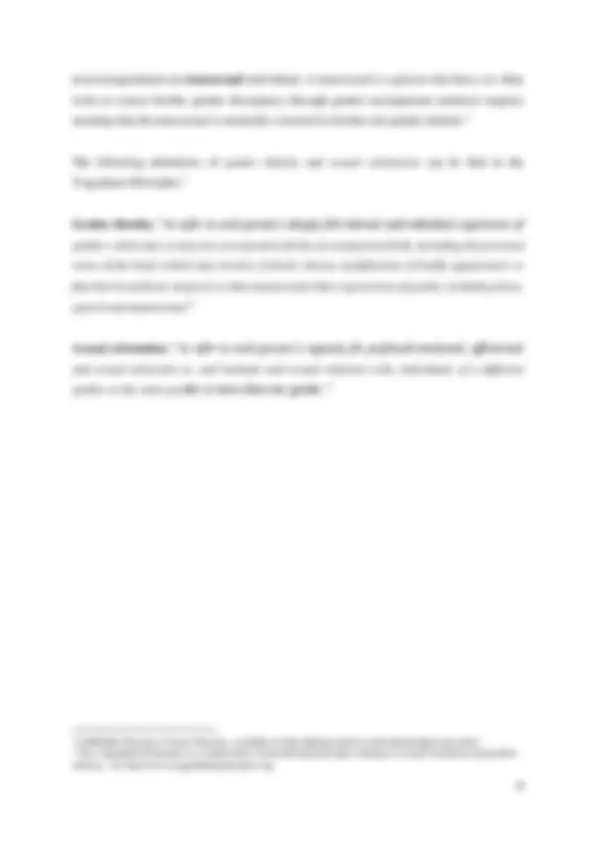
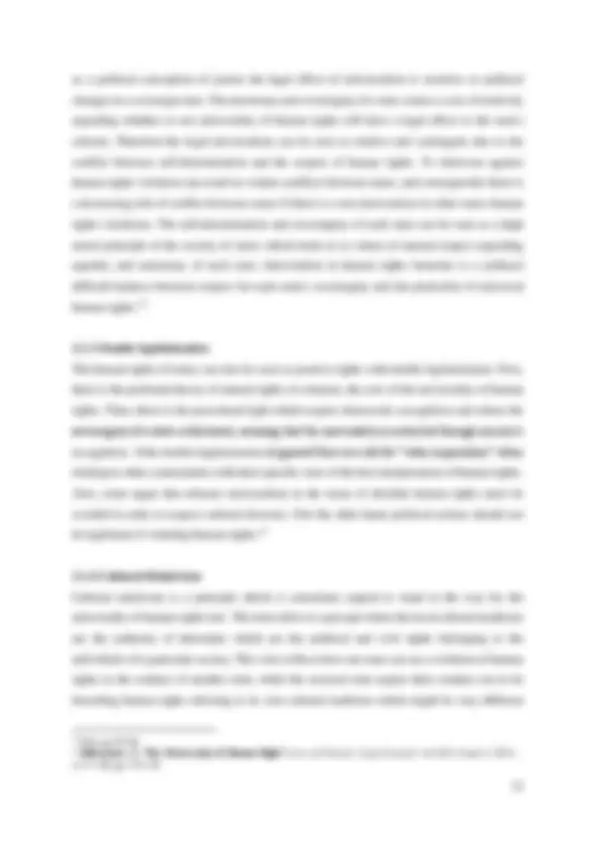
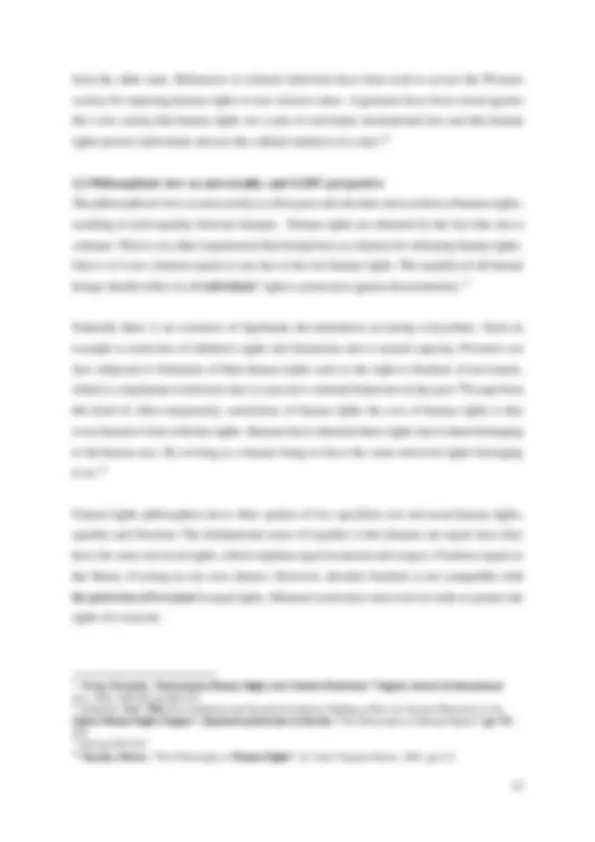
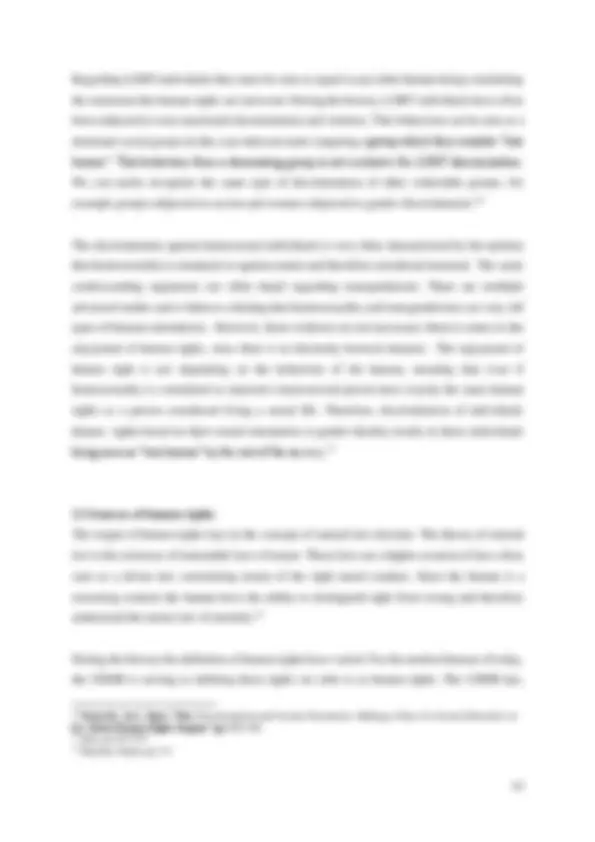
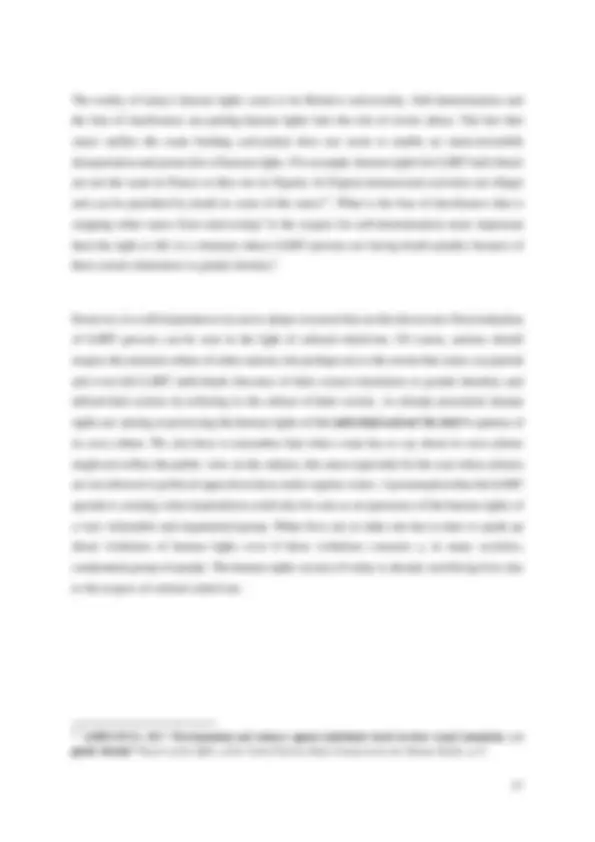
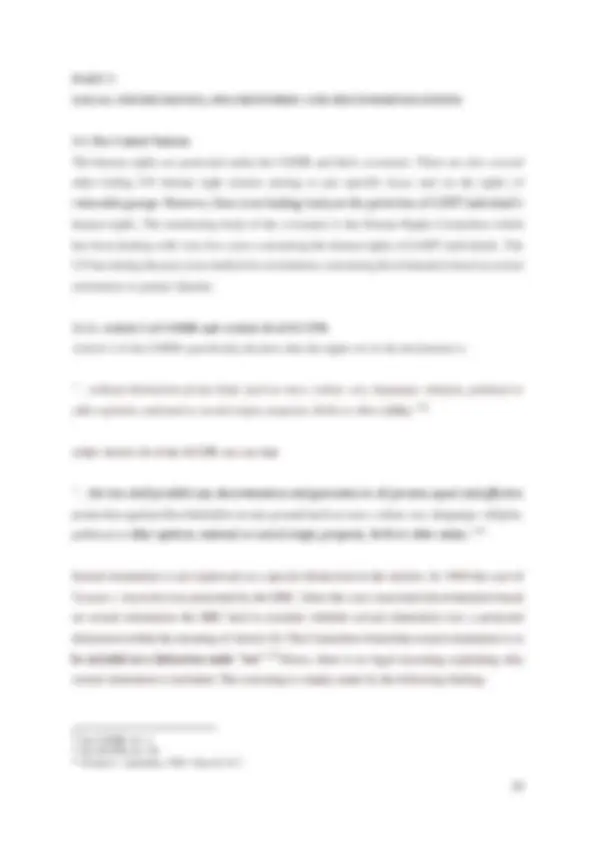
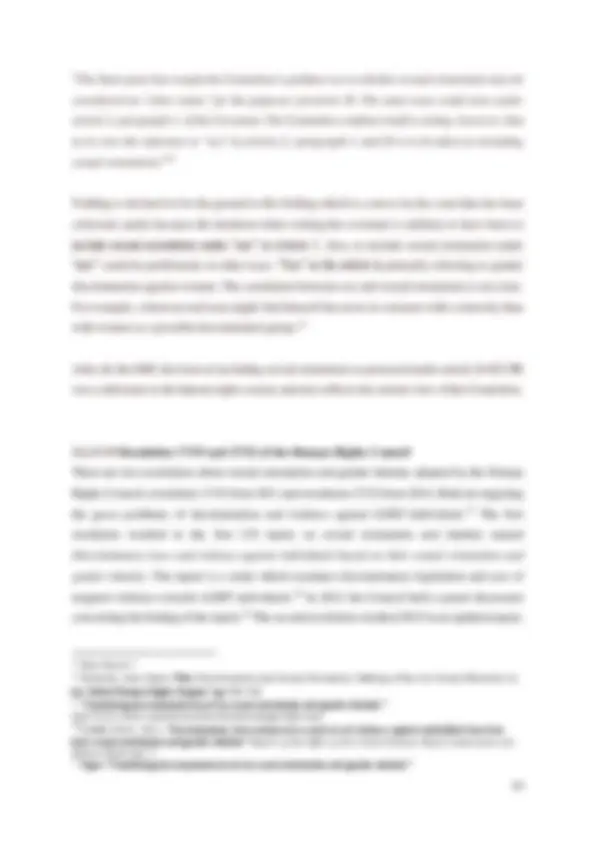
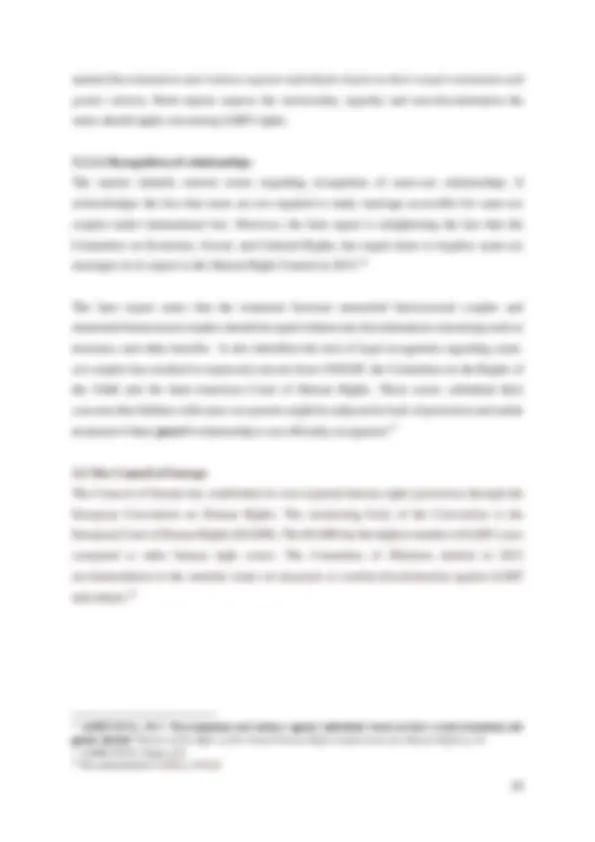
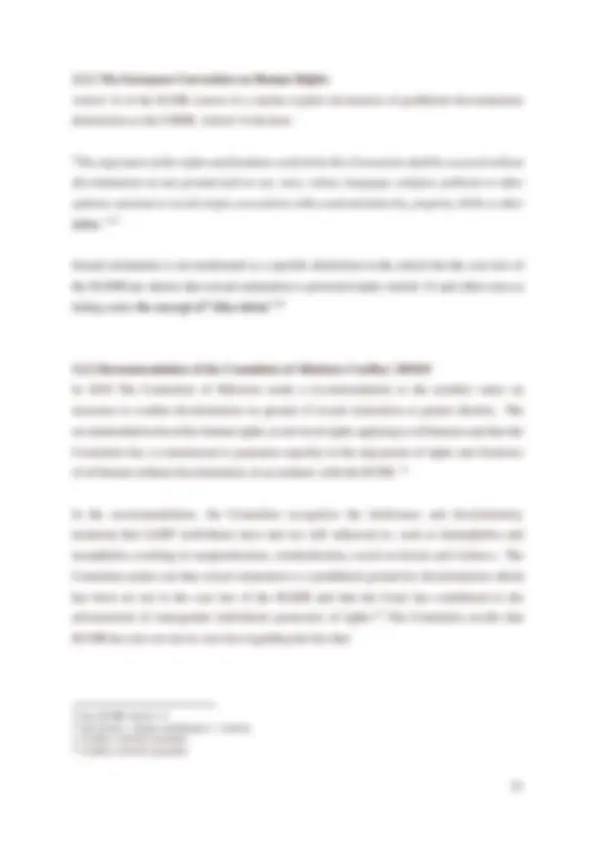
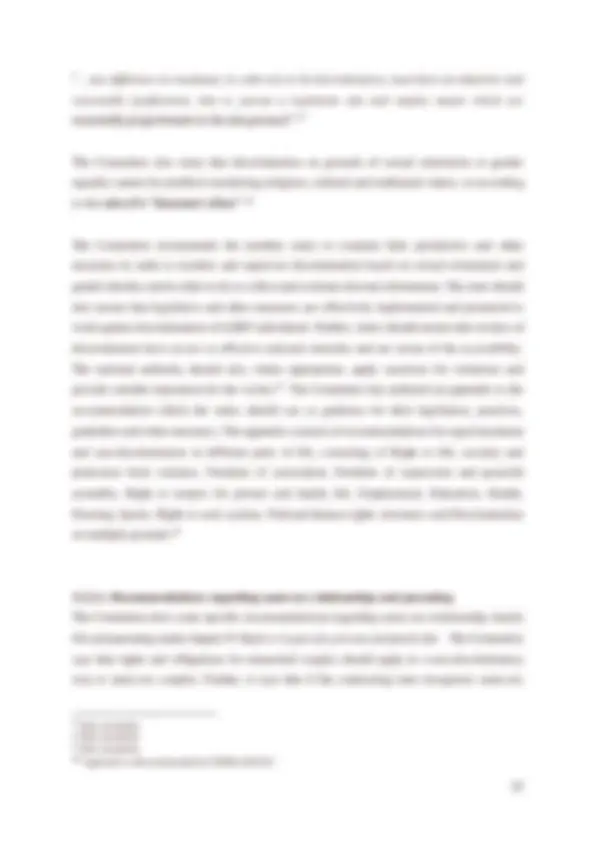
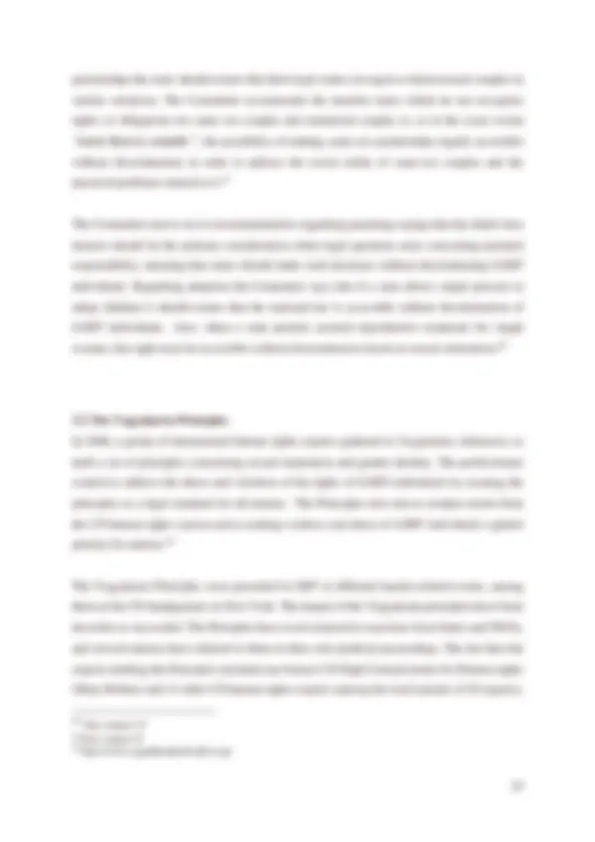
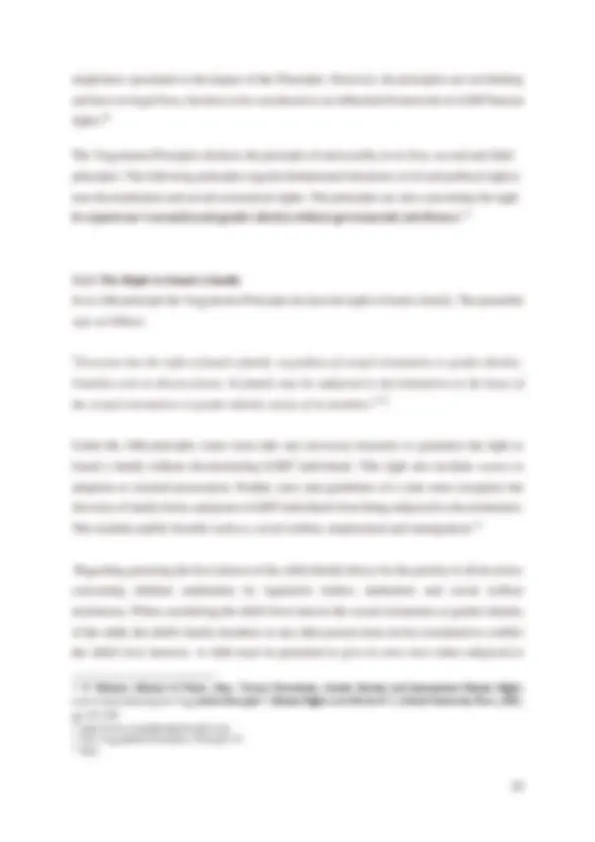
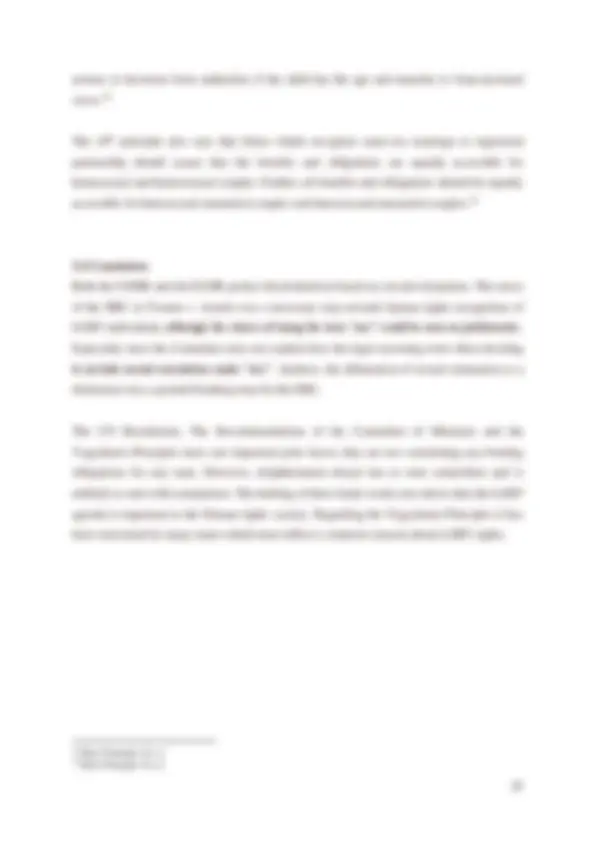
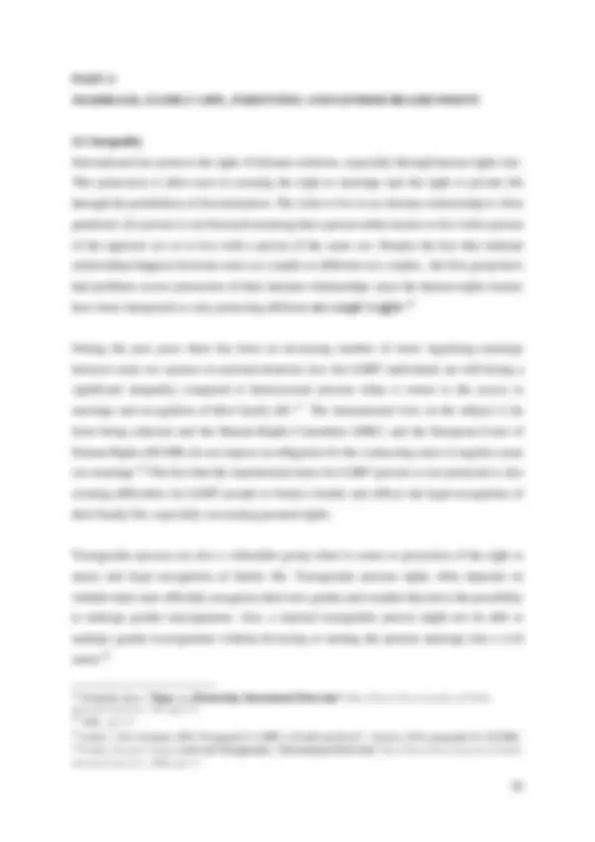
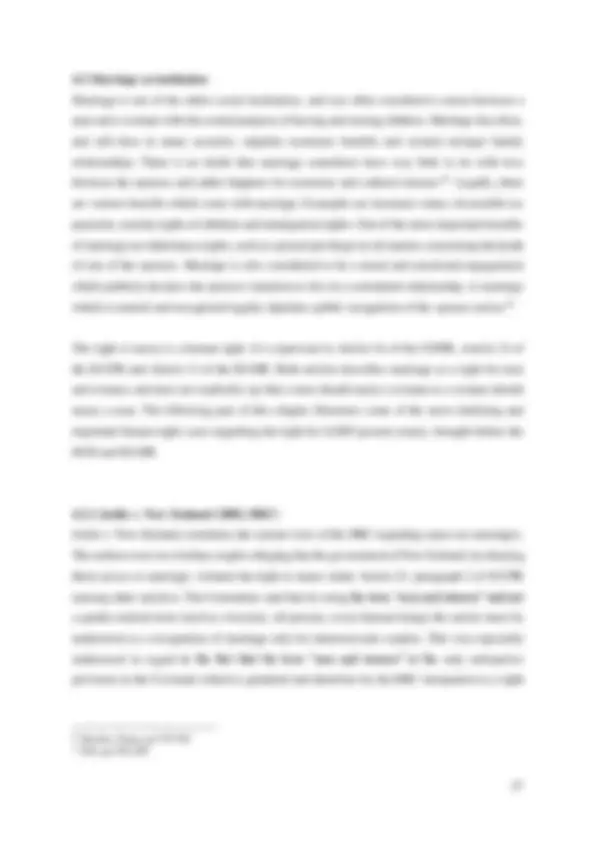

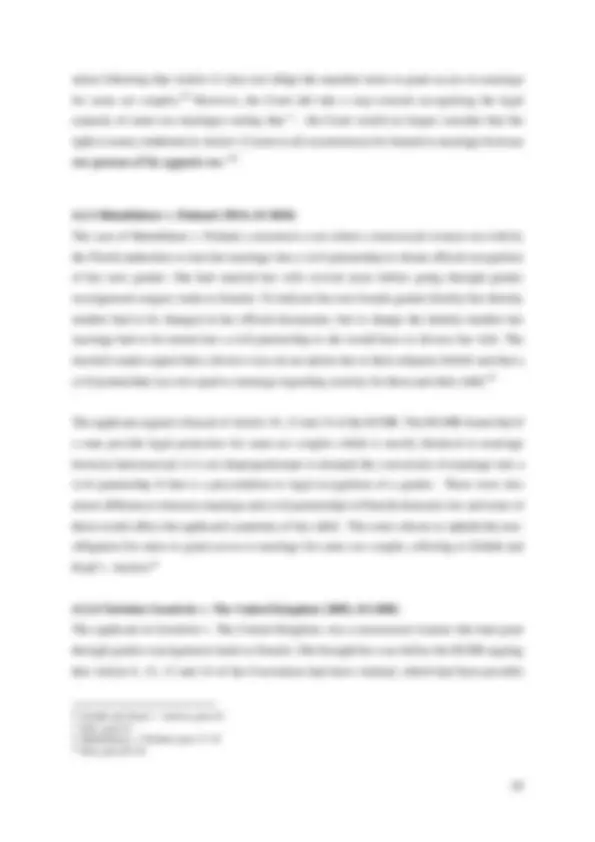
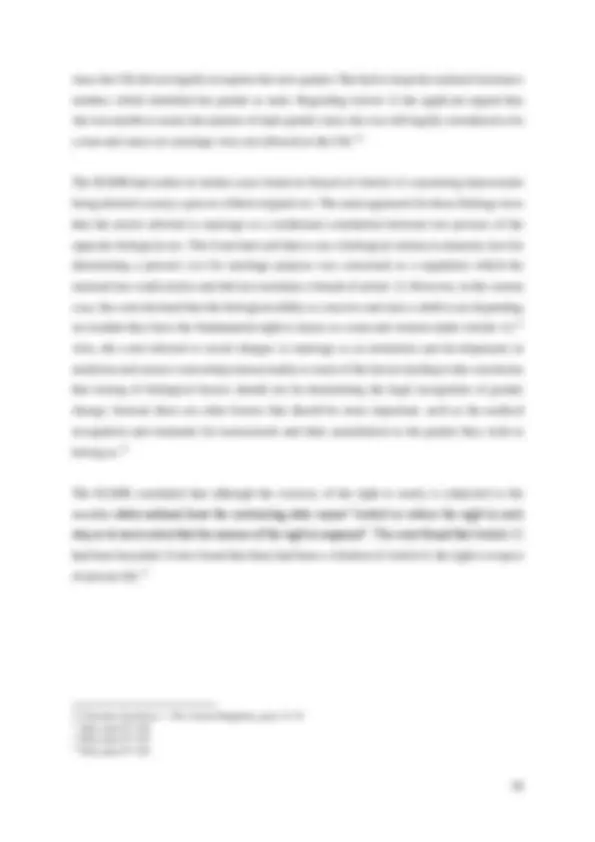
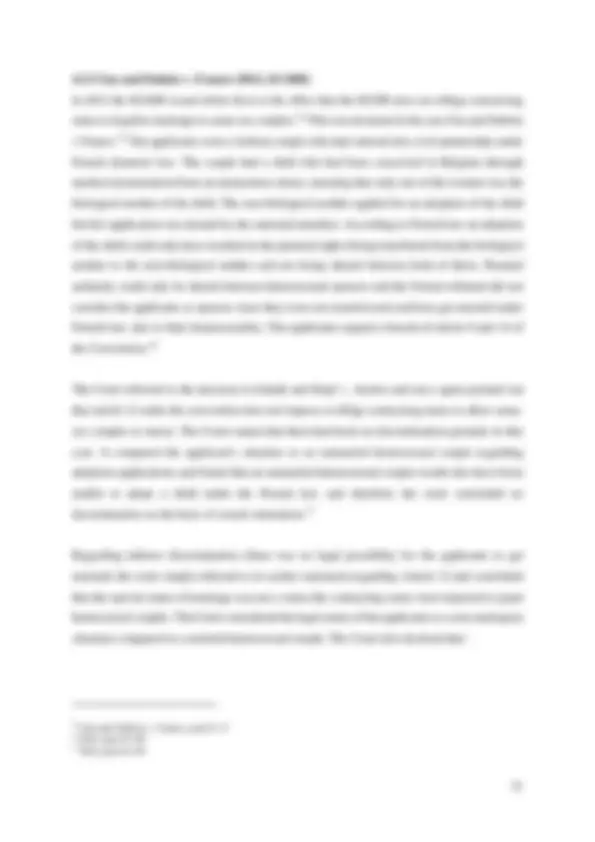
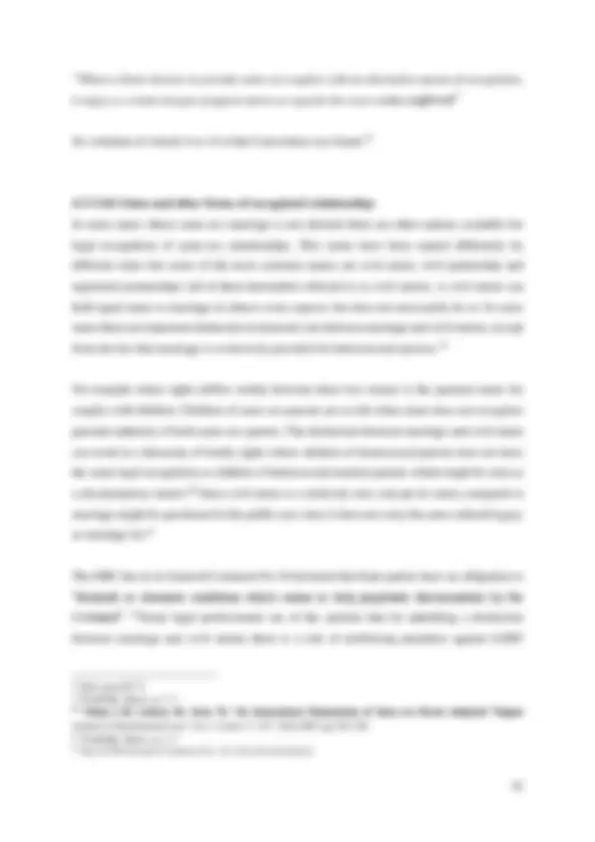
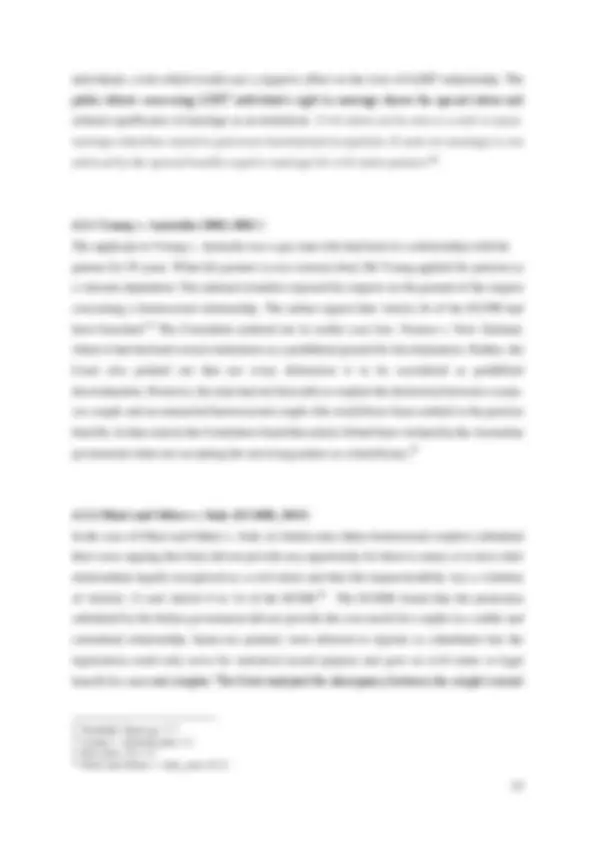
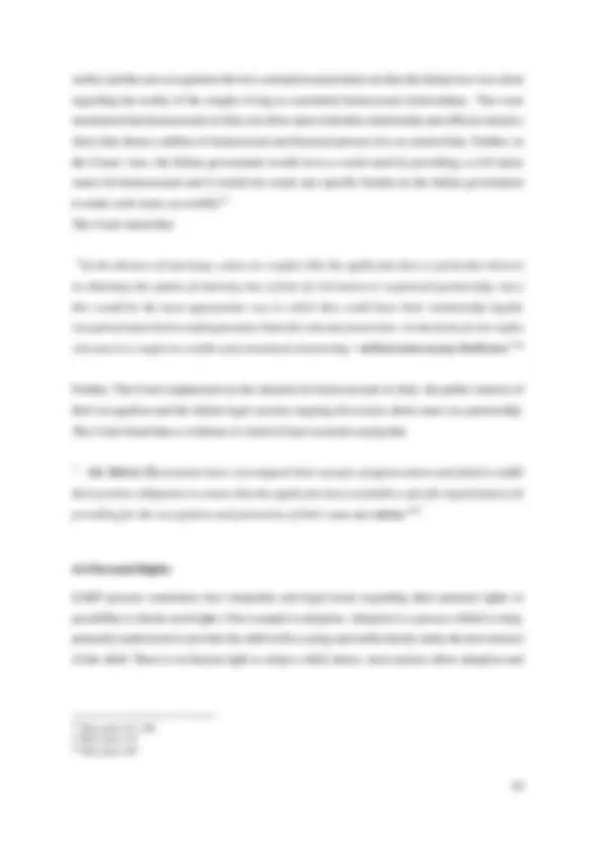
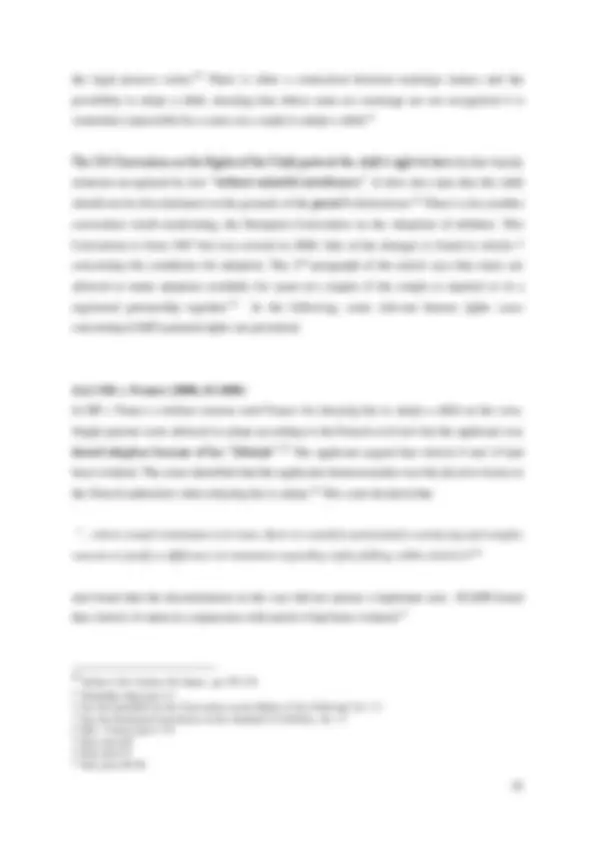
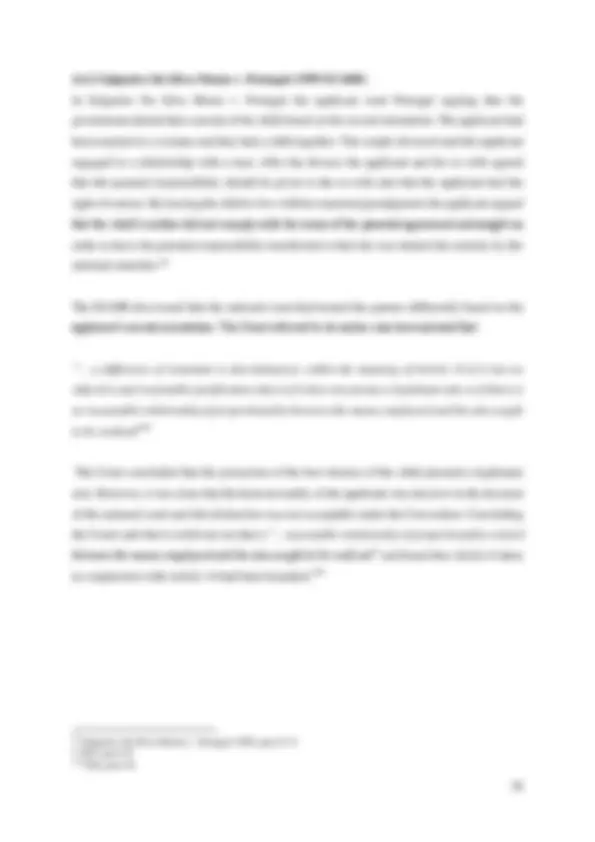
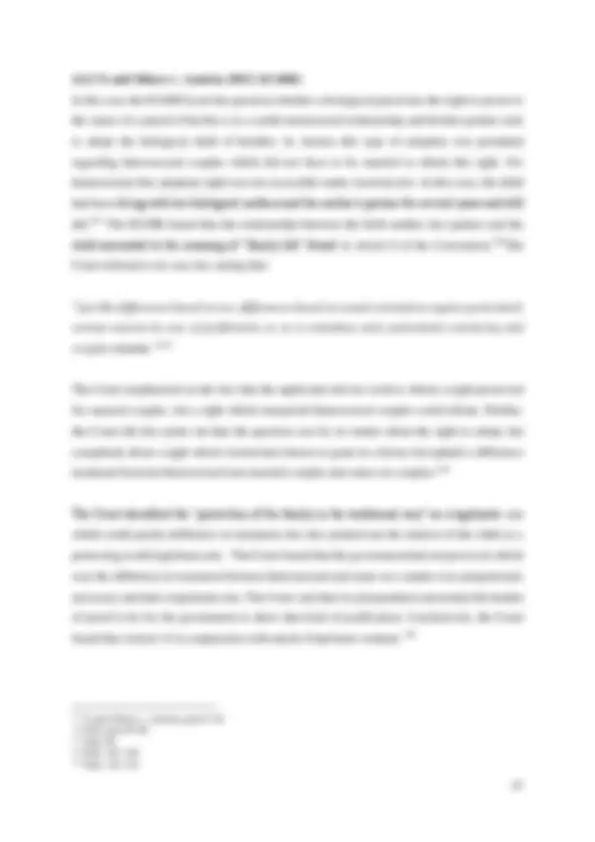
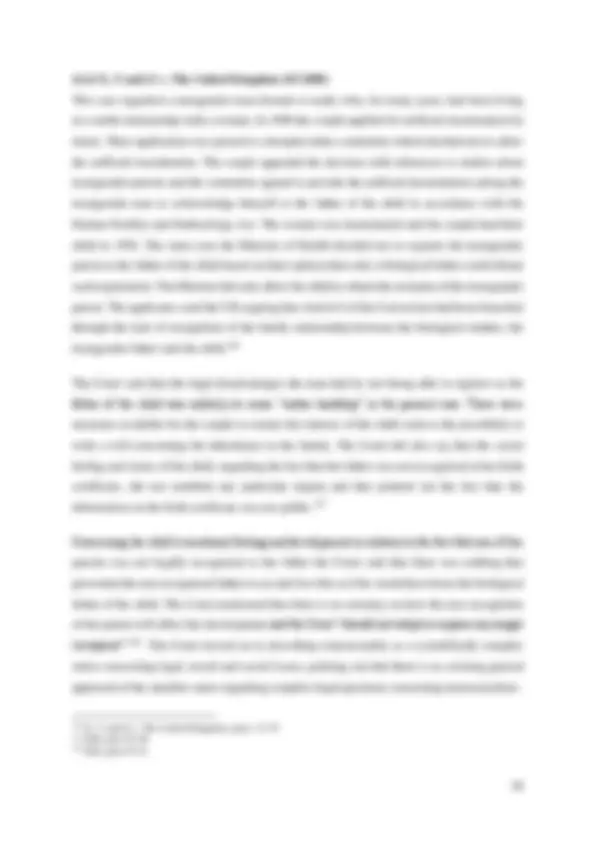
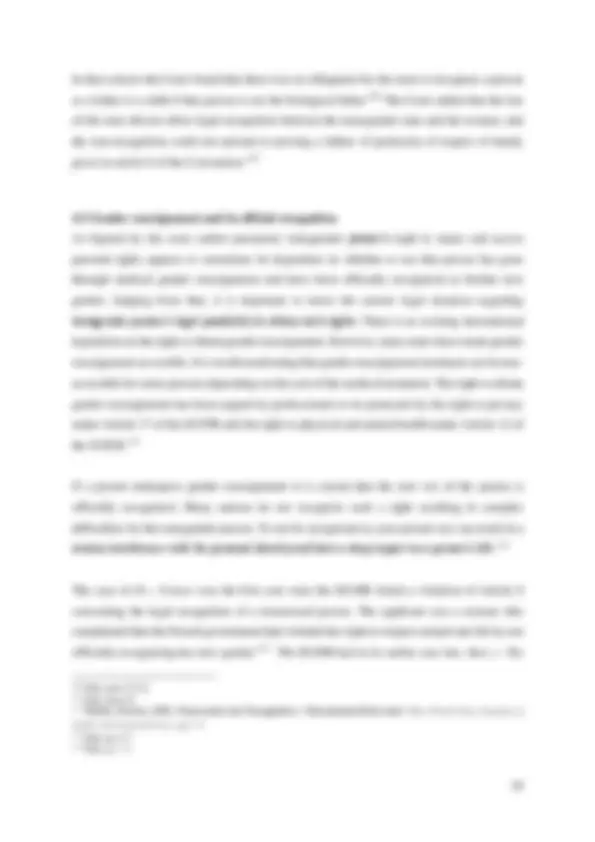
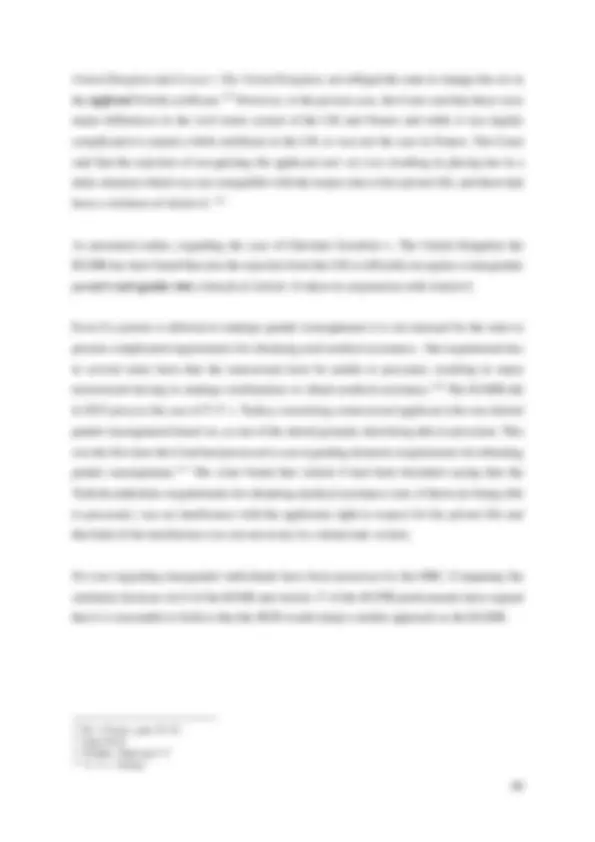
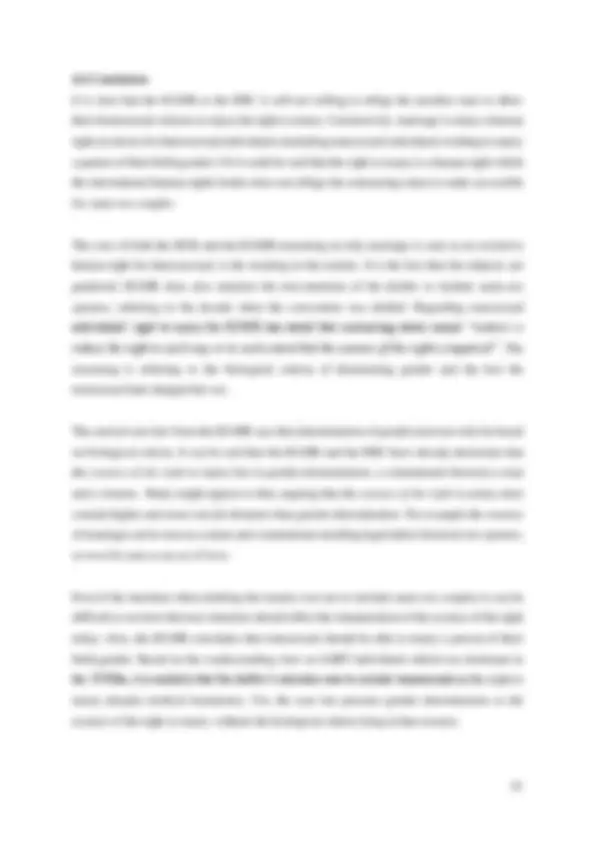
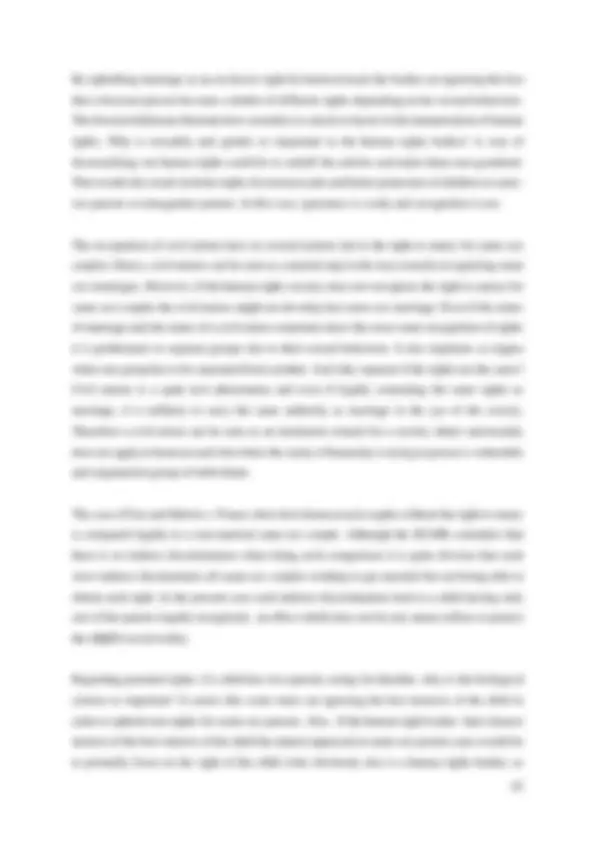
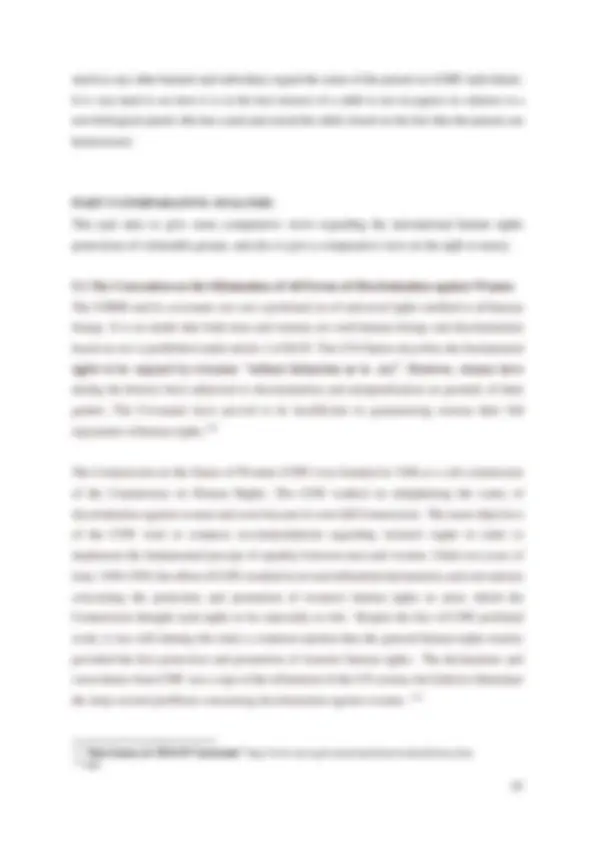
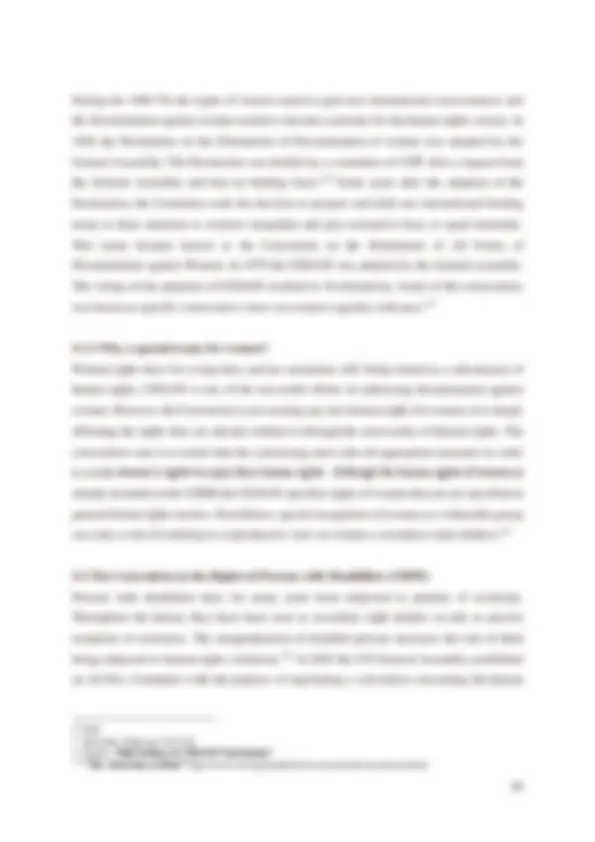
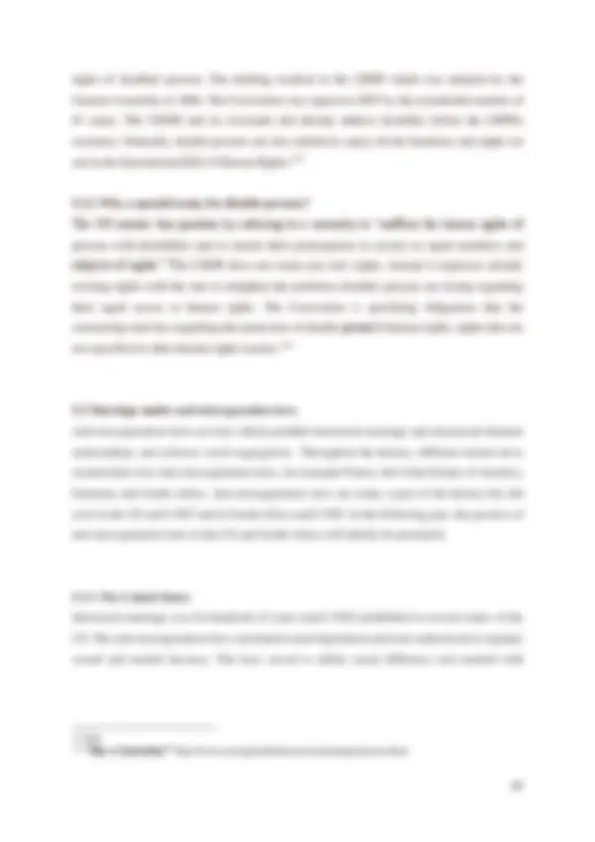
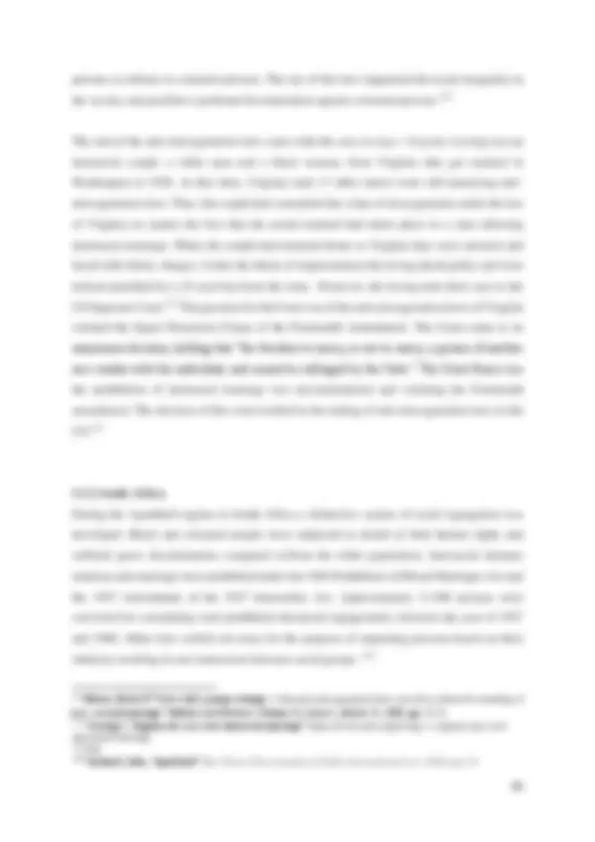
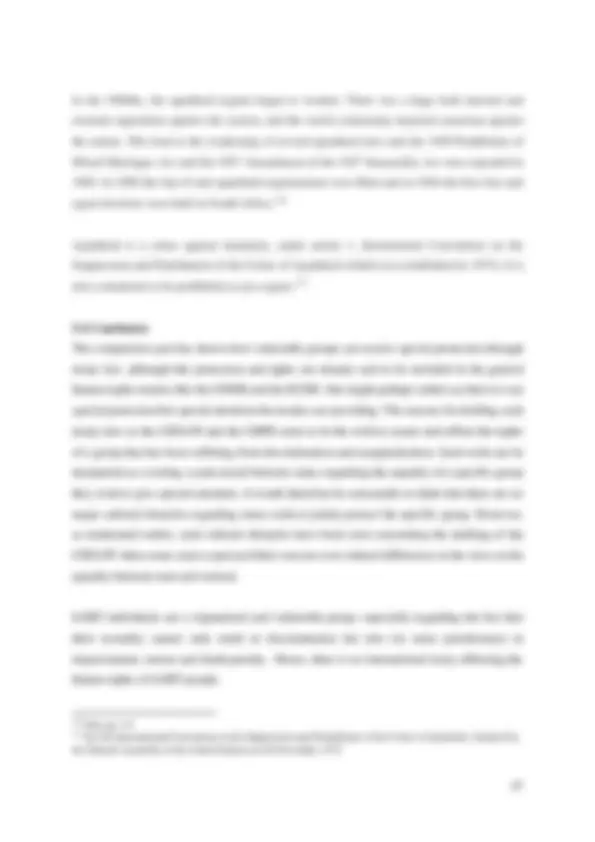
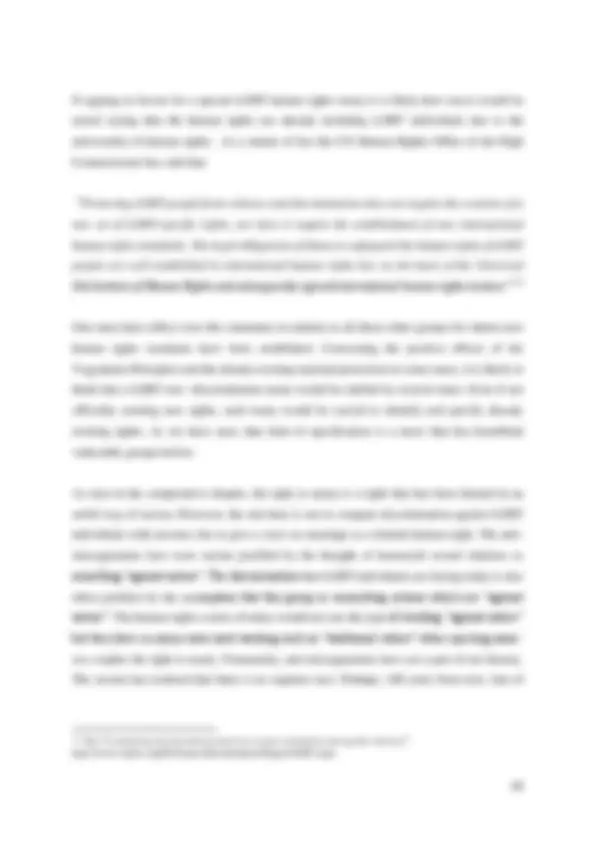
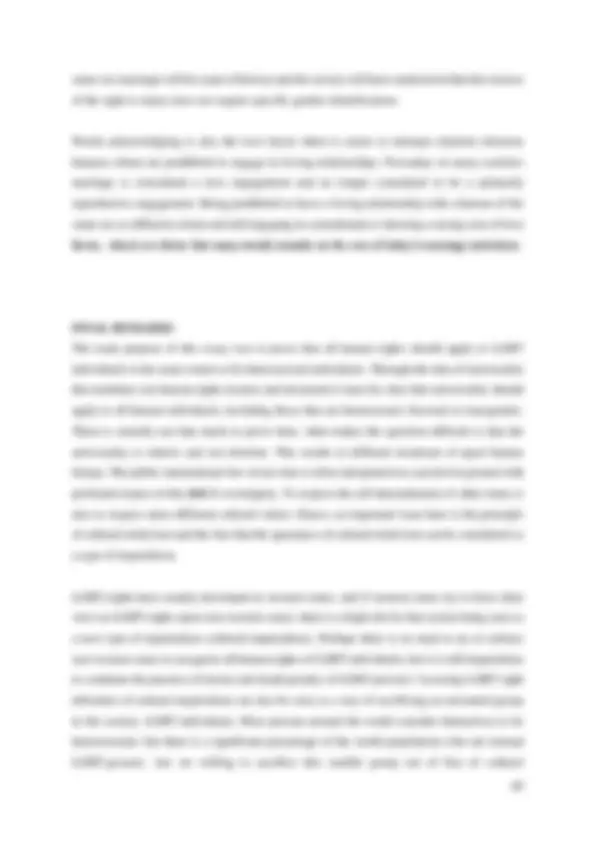
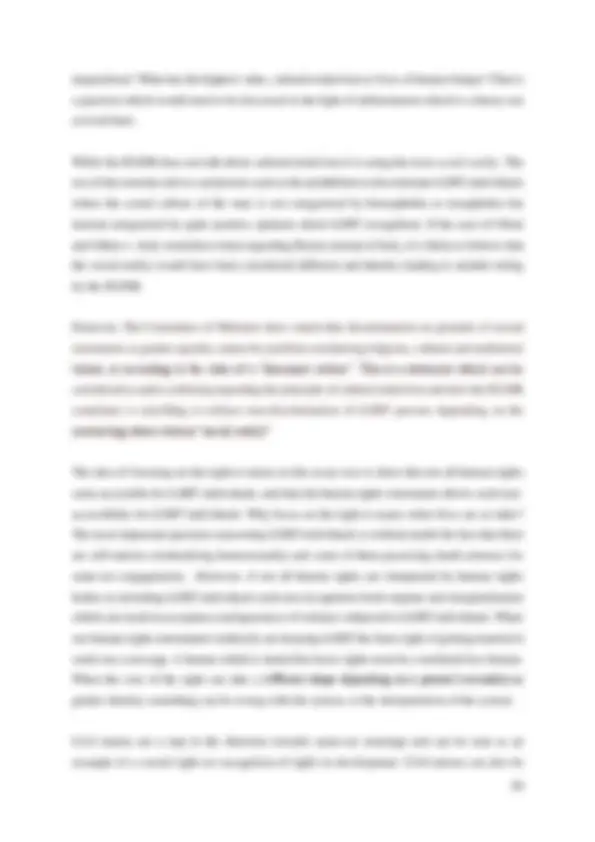
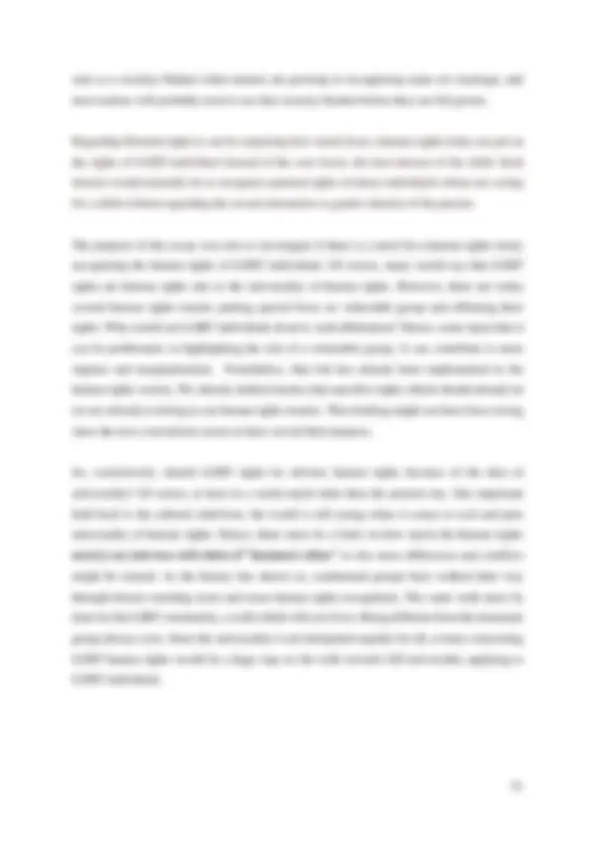
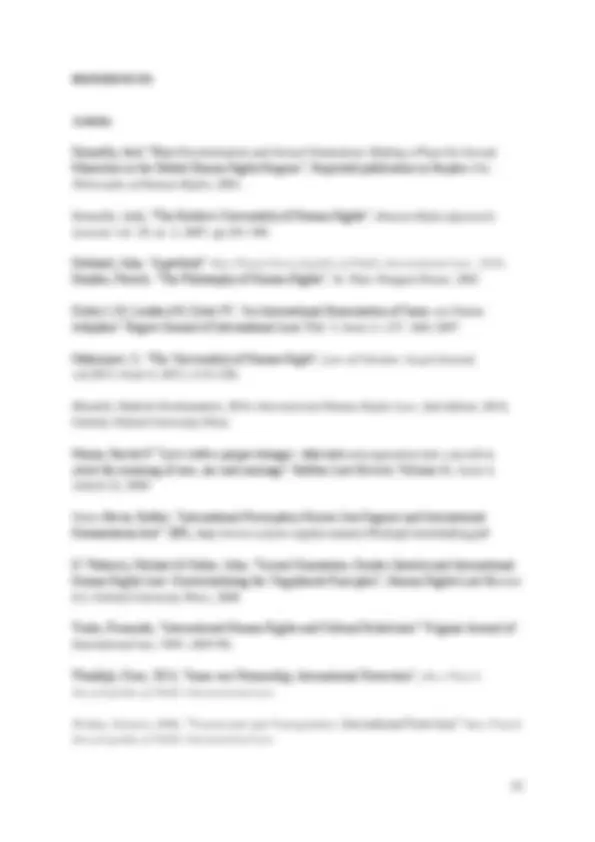
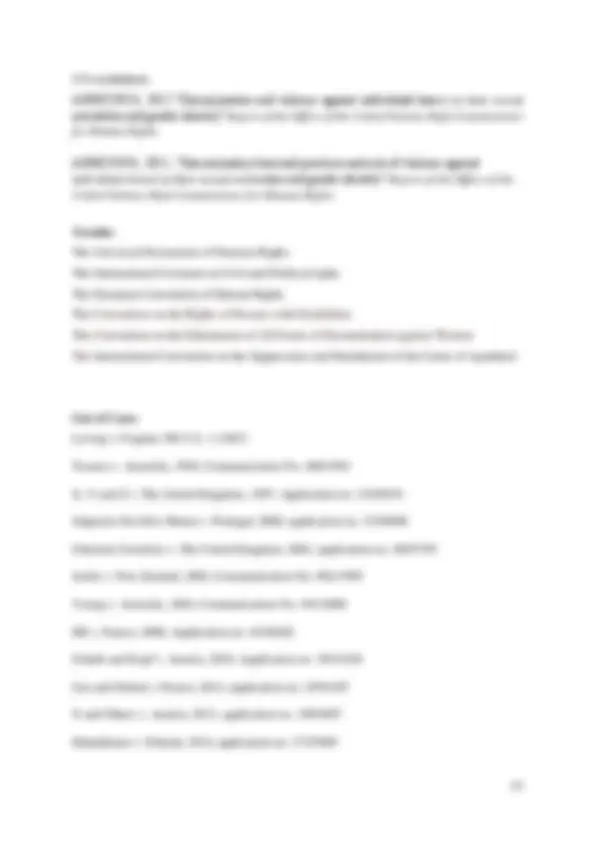
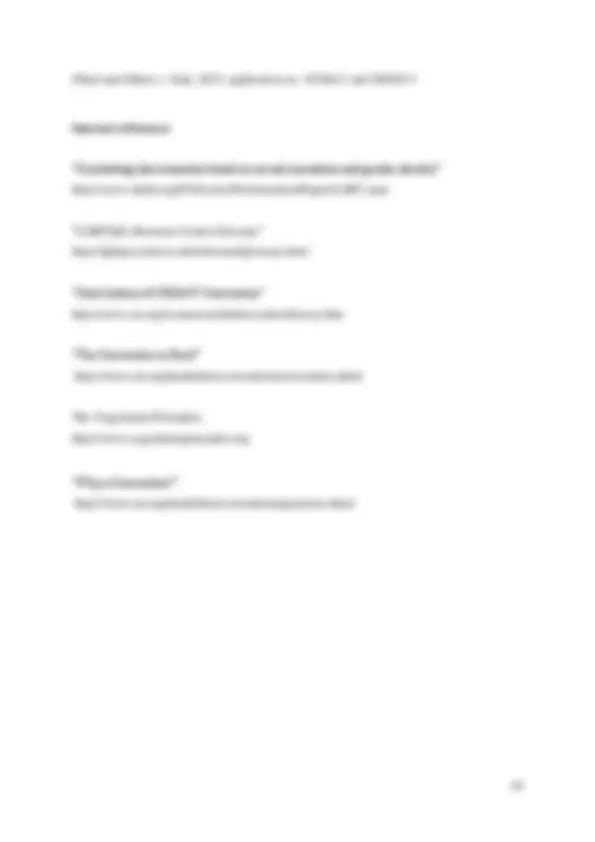


Study with the several resources on Docsity

Earn points by helping other students or get them with a premium plan


Prepare for your exams
Study with the several resources on Docsity

Earn points to download
Earn points by helping other students or get them with a premium plan
Community
Ask the community for help and clear up your study doubts
Discover the best universities in your country according to Docsity users
Free resources
Download our free guides on studying techniques, anxiety management strategies, and thesis advice from Docsity tutors
This essay explores the human rights of LGBT individuals in relation to the principle of universality of human rights. The core focus is on non-discrimination, ...
Typology: Assignments
1 / 55

This page cannot be seen from the preview
Don't miss anything!
















































Stockholm University
Examiner: David Fisher Stockholm, Autumn term 2015
The human rights of LGBT individuals are often ignored, if not deprived, by the world community. The LGBT rights consist of a full set of rights but the exercise of those rights depends according to which jurisdiction of state the LGBT person is subjected to. This essay explores the human rights of LGBT individuals in relation to the principle of universality of human rights. The core focus is on non-discrimination, specifically regarding the right to marry and family rights for LGBT persons. A crucial question examined here is; why are the Human Rights Committee and the European Court of Human Rights interpreting the right to marry as an exclusive right for heterosexual spouses, and why are LGBT individuals excluded from such interpretation? The essay in a comparative method provides for the similarities of LGBT rights and other vulnerable groups, including the right to marry as a universal human right. Further, the need for a specific treaty regarding LGBT rights is analysed.
Key words: LGBT, transsexual, universality, human rights, right to marry, parental rights, gender reassignment, vulnerable groups protection, discrimination.
For the one who colours my world. Thank you
1. Introduction Lesbian, gay, bisexual and transgender (LGBT) individuals are an important group in our society. If not identifying ourselves in this group it is likely that someone among our children, parents, friends or colleagues are persons whom secretly or openly identify themselves as homosexual, bisexual, or transgender. Yet there are still several states where homosexuality is illegal and states where death penalty is imposed for same sex partners engaging in sodomy.^1 The legal progress and understanding of LGBT rights is something that affect us all no matter our own sexual orientation or gender identity. LGBT is a vulnerable group carrying a risk of being subjected to discrimination and physical violence. Furthermore, LGBT individuals are all over the world being denied their human rights and not only by states considered as conservative regimes by the human rights society, but also by modern democracies. Such an example is the rights to marry, a human right which in many states is not accessible for LGBT individuals.
Through the human rights history we have seen how vulnerable groups have received special protection through treaty law, which has resulted in conventions such as the Convention on the Elimination of All Forms of Discrimination against Women and the Convention on the Rights of Persons with Disabilities. It is still a fact that there is no treaty law regarding the protection of LGBT rights and it is still a fact that the European Court of Human Rights does not impose the member states to grant access to marriage for same sex couples. Where is the universality when it comes to human rights for LGBT individuals?
(^1) Homosexual conduct can lead to death penalty in Iran, Mauritania. Saudi Arabia, Sudan, Yemen and in parts of Nigeria and Somalia. See A/HRC/29/23, 2015 “Discrimination and violence against individuals based on their sexual orientation and gender identity” Report of the Office of the United Nations High Commissioner for Human Rights , p 13
1.2 Purpose The purpose of this essay is to prove that all human rights should apply to LGBT individuals to the same extent as for heterosexual individuals, recognising the specific nature of human rights jurisprudence and its universality. Furthermore, the aim is to investigate whether there is a need for a binding human rights treaty concerning LGBT human rights. In order to investigate these statements, this essay will focus on the right to marry and the right to protection of family life in their context as human rights for LGBT individuals. It will also focus on parental rights and the right of transsexual individuals to obtain gender reassignment and official recognition of their new sex.
1.3 Thesis and Research Question My basic presumption is that all human rights should apply to LGBT individuals to the same extent as for heterosexual individuals due to the core of universality of the human rights. Further, my presumption is that discrimination among humans based on sexual orientation is wrong as well as unacceptable and therefore is illegal. In order to prove this assertion, this work will analyze the relevant sources of law relating human rights. The leading question of exploration set for this research is whether or not the existing human rights legal instruments specifically supports the logic of my assertion and if not, whether there is a need for a specific treaty law concerning LGBT human rights. My research also aims to investigate these questions specifically in relation to the right to marry and the right to protection of family life in LGBT-families.
1.4 Method and Material The fact that LGBT human rights is a relatively new subject within the legal debate complicates the access to relevant material within the legal doctrine. Therefore some of the sources used in this essay are related more to the philosophical or political science area than purely legal doctrine. This investigation about the legal situation for LGBT individuals will include legal aspects of LGBT legal issues as it is today, de lege lata , as well as a scenario of how it should be, de lege ferenda. The relevant international legal instruments of human rights, starting from the Universal Declaration of Human Rights in 1948 and the different legal instruments since then to the date, will be discussed and analyzed in view of the equality before the law and equal protection of law concerning LGBT individuals.
term transgendered are transsexual individuals. A transsexual is a person who have, (or often wish to) correct his/her gender discrepancy through gender reassignment (medical surgery) meaning that the transsexual is medically corrected to his/her real gender identity.^2
The following definitions of gender identity and sexual orientation can be find in the Yogyakarta Principles.^3
Gender identity : “ to refer to each person’s deeply felt internal and individual experience of gender, which may or may not correspond with the sex assigned at birth, including the personal sense of the body (which may involve, if freely chosen, modification of bodily appearance or function by medical, surgical or other means) and other expressions of gender, including dress, speech and mannerisms ”.
S exual orientation : “t o refer to each person’s capacity for profound emotional, affectional and sexual attraction to, and intimate and sexual relations with, individuals of a different gender or the same gender or more than one gender.”
(^2) LGBTQIA Resource Center Glossary, available at http://lgbtqia.ucdavis.edu/educated/glossary.html (^3) The Yogyakarta Principles is a framework of international principles relating to sexual orientation and gender identity, see http://www.yogyakartaprinciples.org
2.1 The Universality of Human Rights The human rights of our time are often described as universal and equal for all individuals. Human rights are seen as inalienable rights which all humans have inherited by their birth. The universality idea shines through all the human rights treaties of today and has its background long back in history.^4 Concepts of today’s human rights could be traced back to thousands of years ago developing from ancient civilisations. The Magna Carta is considered to be one of the oldest and most important findings proving the existence of early ideas about the freedom of man. Far later in history the enlightenment thinkers started to speak up about human rights. John Locke spoke of natural rights in words of equality of men and their natural liberty.^5 The US Declaration of Independence was the first constitutional document which in 1776 presented the idea of universality in the words of
“ We hold these truths to be self-evident, that all men are created equal, that they are endowed by their Creator with certain unalienable Rights; that among these are Life, Liberty and the Pursuit of Happiness. ”^6
The first ten amendments to the Constitution became known as The (US) Bill of rights and contain several rights of man. At this time in history, human rights were something only spoken of regarding the own nation. There was basically no recognition of human rights protection under international law and quite unimaginable that a state would interfere in other states treatment of its own citizens.^7
When the Second World War had come to an end in 1945, the international society realized the need for modern international law regarding human rights and international relations. This common will resulted in the UN Charter, signed 1945, recognizing the UN as an intergovernmental organization and requiring the contracting states to promote human rights.
(^4) Moeckli, Shah & Sivakumaran, 2014, International Human Rights Law , 2nd edition, 2014, Oxford, Oxford University Press, pp 5 15 - 23 6 Ibid, pp 15-^21 7 The^ US Declaration of Independence, 1776, second sentence Moeckli, Supra pp 21-
as a political conception of justice the legal effect of universalism is sensitive to political changes in a sovereign state. The autonomy and sovereignty of a state creates a core of relativity regarding whether or not universality of human rights will have a legal effect to the state's citizens. Therefore the legal universalism can be seen as relative and contingent, due to the conflict between self-determination and the respect of human rights. To intervene against human rights violation can result in violent conflicts between states, and consequently there is a decreasing risk of conflict between states if there is a non-intervention in other states human rights violations. The self-determination and sovereignty of each state can be seen as a high moral principle of the society of states which leads us to values of mutual respect regarding equality and autonomy of each state. Intervention in human rights breaches is a political difficult balance between respect for each state's sovereignty and the protection of universal human rights.^14
2.1.3 Double legitimization The human rights of today can also be seen as positive rights with double legitimization. First, there is the profound theory of natural rights of a human, the core of the universality of human rights. Then, there is the procedural right which require democratic recognition and where the sovereignty of a state is disclosed, meaning that the universality is restricted through society’s recognition. If the double legitimization is ignored there is a risk for “value imperialism” when relating to other communities with their specific view of the best interpretation of human rights. Also, some argue that abstract universalism in the sense of absolute human rights must be avoided in order to respect cultural diversity. One the other hand, political actions should not be legitimate if violating human rights.^15
2.1.4 Cultural Relativism Cultural relativism is a principle which is sometimes argued to stand in the way for the universality of human rights law. The term refers to a precept where the local cultural traditions are the authority of determine which are the political and civil rights belonging to the individuals of a particular society. This view reflects how one state can see a violation of human rights in the conduct of another state, while the accused state argues their conduct not to be breaching human rights referring to its own cultural traditions which might be very different
(^14) Ibid, pp 95- 98 (^15) Maksymov, S, “The Universality of Human Right”, Law of Ukraine: Legal Journal, vol.2013, Issue 4, 2013, (114-120) pp 118 - 120
from the other state. References to cultural relativism have been used to accuse the Western society for imposing human rights to non-western states. Arguments have been raised against this view saying that human rights are a part of customary international law and that human rights protect individuals and not the cultural tradition of a state.^16
2.2 Philosophical view on universality and LGBT perspective The philosophical view on universality is often pure and absolute universalism of human rights, resulting in total equality between humans. Human rights are obtained by the fact that one is a human. There is no other requirement than being born as a human for obtaining human rights. One is or is not a human equals to one has or has not human rights. The equality of all human beings should reflect in all individuals’ right to protection against discrimination.^17
Naturally there is an existence of legitimate discrimination occurring everywhere. Such an example is restriction of children's rights and limitations due to mental capacity. Prisoners are also subjected to limitation of their human rights such as the right to freedom of movement, which is a legitimate restrictions due to a person's criminal behaviour in the past.^18 Except from this kind of, often temporarily, restrictions of human rights the core of human rights is that every human is born with her rights. Humans have inherited these rights due to them belonging to the human race. By existing as a human being we have the same universal rights belonging to us.^19
Natural rights philosophers have often spoken of two specified core universal human rights, equality and freedom. The fundamental sense of equality is that humans are equal since they have the same universal rights, which stipulate equal treatment and respect. Freedom equals to the liberty of acting on our own choices. However, absolute freedom is not compatible with the protection of everyone’s equal rights. Minimal restrictions must exist in order to protect the rights of everyone.
(^16) Tesón, Fernando, “International Human Rights and Cultural Relativism” Virginia Journal of International law, 1985, (869 17 - 98) pp 869- 875 Donnelly, Jack “Non-Discrimination and Sexual Orientation: Making a Place for Sexual Minorities in the Global Human Rights Regime”, Reprinted publication in Hayden “The Philosophy of Human Rights”, pp 548- (^55018) 19 Ibid pp.550-^554 Hayden, Patrick, “The Philosophy of Human Rights”, St. Paul, Paragon House, 2001, pp 4 - 6
according to many, become international customary law.^23 The sources of today’s international have a clear embodiment of positivism. This is clearly seen in the Statue of the International Court of Justice, Article 38, in which the sources of international law are listed. The Statue declares the primary source of international law to be international conventions recognized by contracting states. The second source is listed as international customs in the meaning of general practice accepted as law. Thirdly, general principles of law are listed. The last listed source is case law and highly qualified publications of international doctrine.^24
An essential part of international law is jus cogens, a peremptory norm which is so fundamental that it interferes with states sovereignty. Hence, states cannot choose to accept these norms, but have to follow them. There is no explicit list of jus cogens actions but an example of prohibited actions under jus cogens is the prohibition of genocide, apartheid and torture. Jus cogens is generally considered to have its roots in natural law, rising from moral principles such as “the common good for humanity”^25
2.4 Conclusion There is no doubt that the human rights treaties of today carry the words of equality, inability and universalism and it is clear that human rights have the special status such as universal in international law. When it comes to human rights, universality is supposed to mean equality and inclusion of all. The human rights instruments and treaties of today describes universalism in that kind of wording. Hence, the roots of the universality idea are traced back to ancient history but has little to do with how many of us see universality today. What we call the sources of the human rights was a construction which gave value to one type of person, the white man in the west who created slavery, colonialism and imperialism.
The UDHR and its covenants which we refer to as the International Bill of Human Rights, has little to do with the interpretation of the Bill of Rights created by the congress of US in 1789. Back then, the Bill of Rights were of no help to slaves or those suffering under colonialism.
(^23) Moeckli, Supra pp 76- 83 (^24) See the Statue of the International Court of Justice, Article 38. (^25) Nieto-Navia, Rafael, “International Peremptory Norms (Jus Cogens) and International Humanitarian law” 2001, http://www.iccnow.org/documents/WritingColombiaEng.pdf, pp 1-
Also, there is no need to go hundreds of years back in history to see a lack of equality regarding the application of universality to all human beings. One example is the discrimination of black people in the United States during the 1900th century. The UDHR was adopted in 1948 but it was not until 1967 the Supreme Court made interracial marriage fully legal by ruling the Anti- miscegenation laws as unconstitutional.^26
This chapter has described why there should not be any need to argue why LGBT individuals should have the same access to human rights as heterosexual persons. The philosophy behind the concept of human rights speaks for itself. It does not matter if someone believes that the concept of gay relationships are by nature wrong and immoral. A gay person is still a human being and therefore entitled to her human rights due to the fact that she was born into the human race. However, the equality of rights and equal protection of rights is not yet applied universally regarding LGBT individuals.
So what are the consequences if we reject LGBT individuals the enjoyment of all human rights? As presented, one conclusion is that these individuals are then seen as less humans since the society does not let them access the same rights as heterosexuals. The question one have to think about is that if a human is considered less human does she then have the same value as the rest of human beings? And does she have the same access to justice and legal protection from the society? Further, what kind of treatment from full valued humans can a less human individual expect? A transgender person is still a human no matter how that person identifies her own gender and no matter how that individual expresses her gender identity. Discrimination of transgender individuals must therefore also results in a view on the individual as less human than a person with a gender identity which is not in conflict with the birth sex.
It is clear that the international law generally is in accordance with positive law, hence, human rights still have their origin in natural law. However, we have chosen to interpret our human rights with the legal theory of positivism and we have a great respect of other states sovereignty. We have to recall that not all states in the world are parties to the ICCPR. That leaves the citizens of the non-contracting states to only be subjected to protection from Jus cogens actions. Jus cogens itself has an obvious connection to natural law which takes us back to the complicated phenomena of natural law being interpreted by positivism.
(^26) See the ruling of Loving V. Virginia , 388 U.S. 1, (US Supreme Court, 1967)
3.1 The United Nations The human rights are protected under the UDHR and their covenants. There are also several other biding UN human right treaties aiming to put specific focus and on the rights of vulnerable groups. However, there is no binding treaty on the protection of LGBT individual’s human rights. The monitoring body of the covenants is the Human Rights Committee which has been dealing with very few cases concerning the human rights of LGBT individuals. The UN has during the past years drafted two resolutions concerning discrimination based on sexual orientation or gender identity.
3.1.2. Article 2 of UDHR and Article 26 of ICCPR Article 2 of the UDHR specifically declares that the rights set in the declaration is
“…without distinction of any kind, such as race, colour, sex, language, religion, political or other opinion, national or social origin, property, birth or other status.”^28
while Article 26 of the ICCPR sets out that
“…the law shall prohibit any discrimination and guarantee to all persons equal and effective protection against discrimination on any ground such as race, colour, sex, language, religion, political or other opinion, national or social origin, property, birth or other status.”^29
Sexual orientation is not expressed as a special distinction in the articles. In 199 4 the case of Toonen v. Australia was presented by the HRC. Since the case concerned discrimination based on sexual orientation the HRC had to examine whether sexual orientation was a protected distinction within the meaning of Article 26. The Committee found that sexual orientation is to be included as a distinction under “sex”.^30 Hence, there is no legal reasoning explaining why sexual orientation is included. The reasoning is simply made by the following finding:
(^28) See UDHR Art. 2 (^29) See ICCPR Art. 26 (^30) Toonen v. Australia, 1994, Para 8.1-8.
“ The State party has sought the Committee's guidance as to whether sexual orientation may be considered an "other status" for the purposes of article 26. The same issue could arise under article 2, paragraph 1, of the Covenant. The Committee confines itself to noting, however, that in its view the reference to "sex" in articles 2, paragraph 1, and 26 is to be taken as including sexual orientation. ”^31
Nothing is declared to be the ground to this finding which is a move by the court that has been criticised, partly because the intention when writing the covenant is unlikely to have been to include sexual orientation under “sex” in Article 2. Also, to include sexual orientation under “sex” could be problematic in other ways. “Sex” in the article is primarily referring to gender discrimination against women. The correlation between sex and sexual orientation is not clear. For example, a homosexual man might find himself has more in common with a minority than with women as a possible discriminated group.^32
After all, the HRC decision on including sexual orientation as protected under article 26 ICCPR was a milestone in the human rights society and also reflects the current view of the Committee.
3.1.3 UN Resolution 17/19 and 27/32 of the Human Rights Council There are two resolutions about sexual orientation and gender identity adopted by the Human Rights Council, resolution 17/19 from 2011 and resolution 27/32 from 2014. Both are targeting the grave problems of discrimination and violence against LGBT-individuals.^33 The first resolution resulted in the first UN report on sexual orientation and identity named Discriminatory laws and violence against individuals based on their sexual orientation and gender identity. The report is a study which examines discriminatory legislation and acts of targeted violence towards LGBT individuals.^34 In 2012 the Council held a panel discussion concerning the finding of the report.^35 The second resolution resulted 2015 in an updated report,
(^31) Ibid, Para 8. (^32) Donnelly, Jack, Supra “Non-Discrimination and Sexual Orientation: Making a Place for Sexual Minorities in the Global Human Rights Regime” pp.553 33 - 558 ”Combating discrimination based on sexual orientation and gender identity” http://www.ohchr.org/en/issues/discrimination/pages 34 /lgbt.aspx A/HRC/19/41, 2011, “Discriminatory laws and practices and acts of violence against individuals based on their sexual orientation and gender identity” Report of the Office of the United Nations High Commissioner for Human Rights 35 pp1- 3 Supra ”Combating discrimination based on sexual orientation and gender identity”